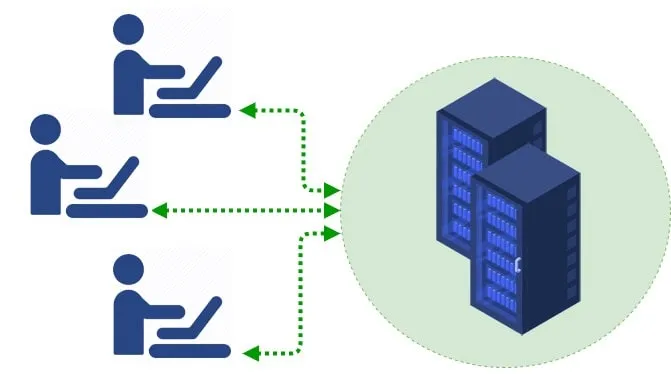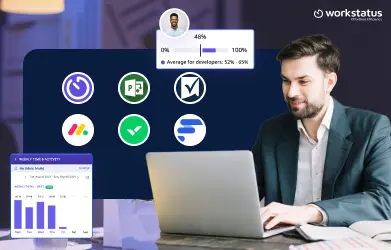Table of Contents
You’ve probably heard of both SaaS and on-premise hosting. SaaS (software as a service) and on-premise are two ways to offer the same software to your customers, but they have significant differences that you need to consider before deciding which to use.
Even though there’s no right answer for choosing which will work best for your business, it’s essential to keep in mind that each type has its benefits and drawbacks and its customers.
If you want to learn more about on-premise vs. SaaS hosting and how you can use each to your advantage, this article can help!
What is On-Premise Software?

On-premise software refers to software on a computer or other device owned by an organization and can only be accessed from that location. One cannot access it remotely outside of that organization; it’s confined to a single location—hence on-premise.
This type of software offers many security benefits, but it also has some limitations and restrictions (such as no integration with third-party systems).
In addition, while on-premise solutions often offer great functionality, they aren’t always updated frequently enough to account for changing industry standards.
An on-premise solution may be ideal if you need to avoid data loss, protect proprietary information, or if you already have adequate security protocols in place to prevent threats.
————————————————————————————————————————-
Also Read: 7 Golden Rules For Time Management
————————————————————————————————————————-
What is SaaS Technology?

Software as a service (SaaS) refers to software that’s hosted in a remote data center, allowing customers to access their applications over an Internet connection from any computer with an Internet browser.
SaaS offers several advantages over on-premise software, including lower capital expenses and more flexibility to scale as your company grows.
However, as a SaaS customer, you’ll need to invest in your infrastructure to handle your daily operations (such as keeping them backed up and managing security). This means that you won’t enjoy much control over these functions as with on-premise technology—but it also reduces costs.
The most significant difference between SaaS and on-premises solutions is that SaaS software is hosted and maintained by a third party, whereas on-premise solutions are kept in-house. The best implementation approach for your business will depend on several variables, including your budget, goals, security standards, and overall corporate culture.
SaaS vs. On-premises Advantages and Disadvantages
Learn about the most significant SaaS vs. on-premises advantages and disadvantages in this section to make an informed decision.
1. Consider Cost
SaaS: One of the significant selling propositions of SaaS solutions is their low starting cost. Because the firm is renting a subscription-based service, spending a big sum upfront is not needed.
Subscription fees are usually charged monthly or annually and correspond to the license type, the number of seats, or the features accessible. While this is a fantastic method to keep costs down, unused licenses and duplicate programs may cause increased cloud expenditure.
On-Premise: On-premises software solutions are costly since the company must buy computer hardware and pay for installation and setup. However, in-house solutions have their own IT infrastructure and staff for maintenance and troubleshooting, which adds to the total cost of ownership. Hardware upgrades entail extra expenditures.
2. Scalability
SaaS: The simplicity with which SaaS applications may be scaled, especially as your business grows, is one of the software’s main advantages. Most vendors allow you to scale up and purchase extra licenses, servers, bandwidth, or storage throughout an ongoing subscription term.
If you wish to downscale during an ongoing subscription period, you’ll probably have to wait until the next renewal, which usually occurs around 12 months after the contract starts.
On-Premise: On-premise solutions are considerably more challenging to scale than SaaS applications, which isn’t surprising.
You’ll need to be prepared for a more time-consuming process and setbacks that may cause business operations to halt for an indeterminate length of time. If you operate a growing company that must be flexible, on-premise solutions aren’t the greatest solution.
3. Support and Maintenance
SaaS: The client is not in command of app maintenance and support since SaaS solutions are ready-to-use products provided by a third-party provider. A cloud vendor must guarantee access and handles disaster recovery in the event of an issue. However, companies should never rely solely on the provider and should verify things like data security and compliance.
On-Premise: For support, software maintenance, and upgrades, the firm is mainly left to its own devices when using this form of implementation. Internal IT personnel with disaster recovery and bug-fixing skills must maintain on-premise software. Although this is a lot of work, there is more data control than SaaS applications.
Also read: The Ultimate Guide To Mobile Workforce Management (MWM)
4. Security and Compliance
SaaS: Contrary to popular opinion, putting your data in the cloud—such as with SaaS apps—is not riskier than keeping it on-premises. Both scenarios can be vulnerable to hackers.
SaaS providers use top-level technologies to safeguard their clients’ data and public image. Even though security and compliance measures are always improving, companies should double-check that they meet their security and legal needs.
On-Premise: Unless you have a committed IT staff that is constantly rolling out the newest security technologies, keeping your data on-premises means exposing it to greater risk than storing it with a third-party provider.
On-premises solutions necessitate the deployment of your own – typically quite costly – security walls and barriers and a thorough understanding of regulatory compliance, and the ability to identify possible intrusions as soon as they appear.
5. Upgrades and Customization
SaaS: Upgrades are another straightforward process to execute when using the software as a service. Most vendors provide tiered licensing options and extra features that may be purchased separately. There is also a level of customization that businesses should take advantage of; after all, one size does not fit all.
On-Premise: On-premises solutions require much more planning and greater up-front investment to upgrade. It’s critical to hire competent IT professionals who accept responsibility for the entire planning, deployment, and control processes.
However, in-house development teams have greater control over customizing or adding unique features when compared to cloud-based software.
Also Read: Top 10 saas applications
6. Analytics and Functionality
SaaS: SaaS applications allow you to customize or remove features as needed, which is excellent for your company’s needs. Before the vendor releases them, these features are completely built and ready to use.
This implies that you won’t need to hire third-party experts or development teams to implement the features you require. Another advantage is that SaaS applications provide sophisticated reporting capabilities that simplify understanding how users use the system and what data they produce.
On-Premise: Functionality for on-premise solutions is frequently quite restricted. Most businesses that currently use on-premises software have purchased huge software suites that are difficult to modify or re-install. Second, tailoring one element necessitates altering the whole network to incorporate new processes into the old system.
7. Recovery and Backup
SaaS: Most cloud storage services provide automatic backup of your data. It’s simple to retrieve your data in the event of a technical catastrophe, which relieves stress off your in-house IT staff. Depending on the product, backup and recovery services might be included in your subscription plan. There may be an extra charge for including these essential features.
On-Premise: Maintaining recovery systems for on-premises technologies is very expensive. The most efficient approach to back up data is to have a duplicate data storage that can be utilized when the primary processors fail. Backup services help companies protect their data from sudden natural disasters or human error. Without adequate investment, businesses risk losing their data and their reputation.
——————————————————————————————————————————–
Also Read: Agile Project Management: Lean Requirements Practices for Teams, Programs, and the Enterprises
———————————————————————————————————————————
Who Should Choose On-Premise And Who Should Choose SaaS?
While both solutions are robust, they’re suited to different businesses, which helps explain why some companies choose one over another. The advantage that on-premise services have over SaaS solutions is customization. With Saas, a company buys into someone else’s vision of how things should be done and what features it should offer.
However, that also limits your business because you can only take advantage of features that come with your Saas solution (there may be an abundance of them, but there’s no way to know in advance).
An excellent example of where you might use on-premise instead of SaaS is government agencies or banks–where regulations require certain functionality or security measures that might not fit in with a generic SaaS platform.
Other organizations, especially startups, are likely to benefit from a SaaS solution because they’re relatively easy to use and deploy quickly. SaaS tools such as Workstatus can improve the overall growth of businesses of any size.
In the next section, we will learn about how Workstatus can play a major role in improving your business operations.
When choosing between SaaS and on-premise, the real deciding factor is cost/benefit analysis—which option will save you money in both time and resources or give you more freedom as an owner or manager?
If there’s no clear winner at first glance, take some time to figure out what questions would need answering before deciding one way or another—for example, by talking with a few people who work in similar businesses using either option.
Workstatus- A Great SaaS Application For Workforce Management
Workstatus is a great workforce management software because it offers a comprehensive range of features covering all aspects of managing a team of any size.
Some of its great set of features include:
- Time Tracking – Workstatus’ time tracking feature allows you to track the time your employees spend on each task, project, or client. This makes invoicing and billing much more effortless.
- Employee Monitoring – Workstatus’ employee monitoring feature lets you see in real-time what your employees are working on. This helps to ensure that they are productive and not wasting time.
- GPS Time Tracker – Workstatus’ GPS time tracker provides you with detailed reports on where your employees are at all times. This is great for ensuring that they are not working from home or elsewhere without proper authorization.
- Payment Processing – Workstatus’ payment processing feature makes it easy to pay your employees on time and accurately. This is vital for keeping your employees motivated and happy.
- Client Management – Workstatus’ client management features allow you to keep track of your client’s contact information, project deadlines, and invoices. This helps to keep your projects on track and your clients happy.
- Reporting – Workstatus’ reporting features give you detailed insights into your employees’ work habits. This allows you to identify areas where they may slack off or not perform up to par.
Workstatus’ comprehensive features make it an excellent workforce management software for any business. If you’re looking for a way to improve your employees’ productivity and efficiency, Workstatus is definitely worth considering.
Closing Thoughts
Every business needs a platform to launch, grow and thrive. And while SaaS (Software as a Service) platforms offer flexibility and affordability, on-premise solutions may be a better fit for your business — at least in certain instances. Knowing which one works best can be tricky; that’s why it’s essential to weigh all of your options and thoroughly research each choice before making a final decision that could ultimately affect your overall success.
The key is to remember that there are no rules of thumb or universal standards; every scenario is different and requires careful analysis and planning before moving forward with any solution. Understanding what each option entails will help you decide which direction suits your business model best.
Thanks for reading!!












